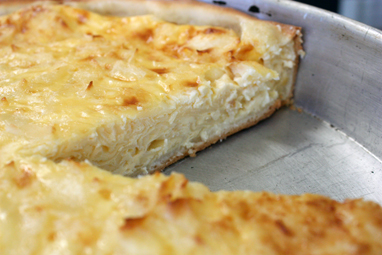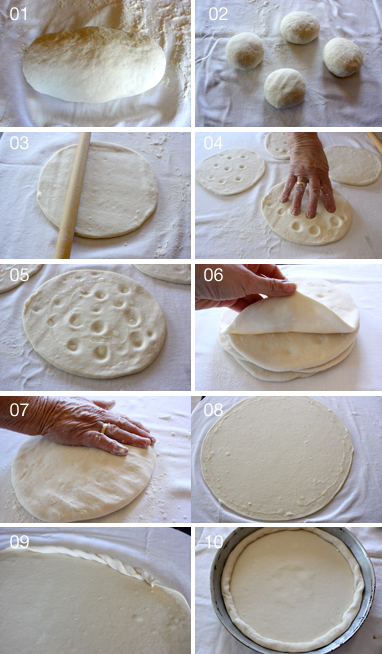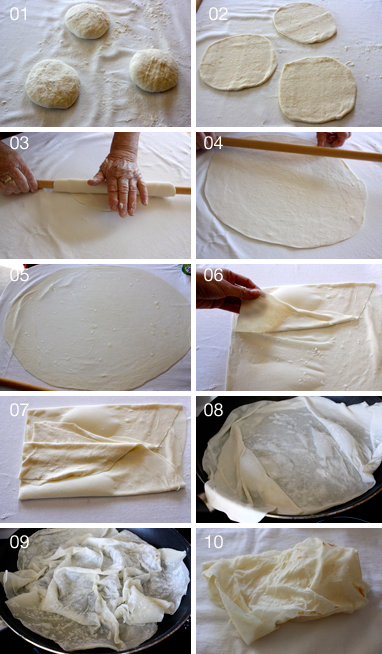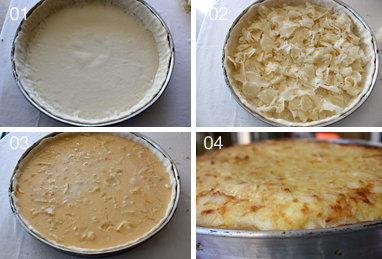Village Egg and Milk Pie (Mlechnik)
This recipe was handed down to my baba by my great grandmother so it’s been in the family for generations. Mlechnik is Macedonia’s answer to quiche, a rustic egg and milk pie made with hand rolled pastry.
Typically made during spring, when the chooks are laying fresh eggs in abundance, this pie is also comforting during the cooler months.
Two types of dough are required, the first includes yeast and is used for the base, the second is yeast free and similar to filo pastry sheets. If you’re stretched for time or find working with dough challenging, a similar, although admittedly not as tasty result can be achieved by replacing the base with store bought puff pastry and a couple of lightly browned filo pastry sheets for the filling.
Our family preference is a basic egg and milk mlechnik, although other regions have been known to add crumbled feta and buttermilk or sour cream.
……………………………………………………………………………………
Recipe
Serves 14
Ingredients
Base
Sponge (yeast mix)
1 (7g) packet dry yeast
1/2 teaspoon caster sugar
1 tablespoon plain flour
1/4 cup (60ml) lukewarm water
Dough
3 cups (375g) 00 plain bread flour, sifted, plus extra for dusting
1 teaspoon sea salt
2 tablespoons (40ml) vegetable oil, plus extra for drizzling/brushing
1 cup (250ml) warm water
Pastry sheets
2 cups (250g) 00 plain bread flour, sifted, plus extra for dusting
2 teaspoons sea salt
1 tablespoon vegetable oil, plus extra for drizzling/brushing
3/4 cup (190ml) warm water
Filling
13-14 free-range or organic eggs, room temperature
1 litre full cream milk, room temperature
1 tablespoon sea salt
You will need:
– Large round 16†baking tray
– Small bowl (for sponge)
– Large mixing bowl (for dough)
– Clean tablecloth or bench
– Long thin rolling pin (make your own by purchasing a 1.2m length of unfinished dowel from your hardware store and sand until very smooth)
– Large non-stick frying pan
– Large bowl (for egg filling)
– Foil sheet
Method
1) Grease large round baking tray with oil (approx. size 40cm in diameter, 4cm high).
2) To make sponge, stir yeast, sugar, flour and water in small bowl until smooth (1 minute). Allow to rest (7-10 minutes) or until double in size.
3) Sift flour and salt into a large mixing bowl and make a well in the centre. Add sponge mix, oil and 2/3 of the warm water and begin to incorporate using one hand while the other turns the bowl, if the dough is too dry add a little extra water (you may not need to add all the water). Knead until the dough comes together (3-5 minutes) and turn out onto a flour dusted surface and continue to knead until smooth (3-5 minutes).
4) Divide the dough into 4 equal portions, dust with flour and knead into round balls. Using the palm of your hand flatten each ball, then roll out to 20cm in diameter, dusting as you go to avoid the dough from sticking to the rolling pin. Use your fingers to create dints in each disc (this will help the oil pool). Drizzle each disc with olive oil and spread the oil all over using your fingers or a brush (I find using my fingers quicker and easier).
5) Layer 3 discs, oil side up on top of each other, place the final disc oil side down and press the edges with your hand to help seal the oil. Turn over and continue pressing with the palm of your hand from the centre to the edges until an even thickness and 30cm in diameter. Dust the top with flour and roll out to 5-10cm larger than the base of your tray. Drizzle oil around the edge of the pastry, spread with your fingers then loosely roll the edges over to create a 2cm high boarder and place in your oiled tray.
Note: The dough should fit snugly in your tray, if necessary stretch out slightly or push in the dough in to help it fit.
6) For pastry sheets, sift flour and salt into a large mixing bowl and make a well in the centre. Add oil and 2/3 of the warm water and begin to incorporate using one hand while the other turns the bowl, if the dough is too dry add the remaining water. Knead until the dough comes together (3-5 minutes) and turn out onto a flour dusted surface and continue to knead until smooth (5-7 minutes).
7) Divide the dough into 3 equal portions, dust with flour and knead into round balls. Using the palm of your hand flatten one of the balls, then roll out to 20cm in diameter, dusting as you go to avoid the dough from sticking to the rolling pin and set aside. Repeat with other 2 dough balls.
8) Heat a large non-stick frying pan (high heat).
9) Using the first flattened disc, dust both sides generously with flour and dust the rolling pin. Roll out to an even circle (30-40cm in diameter). Dust with flour again, wrap one end of the sheet over the rod and quickly roll while gently pulling the dough, unroll in the opposite direction, i.e. if rolling from the left, when unrolled the rod will end up on the right. Use your rod to gently roll and even out the circle. Dust again and repeat this process another 15-20 times until 50cm in diameter (2mm thick), dusting the edges if they stick. Drizzle over oil and use your fingers or a brush to spread the oil. Gently pick up the edge closest to you and fold the sheet in half, dust with flour and fold in each edge. Transfer the pastry sheet folded side up and place in your hot frying pan. Once the underside begins to dry out (2-3 minutes) turn over and cook for another 2 minutes. Being careful not to burn yourself, use your fingers to unravel the sheet, concentrate on lightly browning the uncooked centre and edges and continue rotating until lightly coloured all over (3-5 minutes), remove from pan and allow to cool. Repeat with remaining dough.
Note: For a quick version, oil and lightly brown 8-10 store bought filo pastry sheets in a moderate oven.
10) Preheat oven to 250°C.
11) In a bowl combine eggs, milk and salt, whisk until well combined
(3 minutes) and set aside.
12) With the prepared dough in the base of your large round baking tray, evenly press the rolled edge into the side and up to the height of to the top of the rim to form an even crust.
13) Roughly tear the cooked pastry sheets into small pieces an evenly spread over the uncooked base. Drizzle with oil, then pour over egg and milk mix, pushing down all the torn pastry to ensure everything is submerged.
14) Cover tightly with foil and bake for 30 minutes at 250°C. After 30 minutes uncover, reduce temperature to 200°C and bake for further 25-30 minutes or until lightly golden and cooked through. If the top browns too quickly loosely cover with foil again.
15) Remove from oven and allow to stand uncovered for 15-20 minutes. Cut and serve while warm with a fresh tomato salad and generous chunks of sheep/goats’s milk cheese or buttermilk.
Tips:
– For a richer pie add crumbled feta to the egg mix.
– Refrigerate for up to 3 days. Mlechnik also tastes good served cold during summer and perfect for picnics.
– For a quick version use store bought puff pastry for the base and lightly browned filo pastry sheets for the filling.














 are preserved and enjoyed
are preserved and enjoyed
Mara
Well done Suzanne (and to Baba Tala)…. this recipe has never been published anywhere before (I’ve been looking for ages, but never found it!) This is exciting! My Baba use to make Mlechnik this way too, with the cooked ‘kori’. Love it! Keep the classics coming…
Leni
Oh my God!! A Gavato specialty, to die for, my Baba made this for so many holidays. Thank you so much for publishing a recipe. I make it exactly the same way, for a short cut, the thick serbian kora used for Gibanica, bake and are exactly the same as the streched ones, they bake up and crumble very nicely. My Baba also use a stick of melted butter on the kore before putting in the egg mixture, excellent flavor and moistness. Keep up the old time recipes, I love your website!!